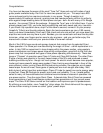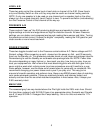
BACK PANEL
Now that we've mastered the Front Panel and found its simple layout easily digested let's
move aft for some jacks and tubes. Let's take the connections first and start with the jack
panel.
INPUTS B/A:
Here in the upper left corner of the jack panel you'll find two 1/4” insulated jacks. These are
the inputs for pre-amps and/or effects, depending on how you wire your system. You may
drive the 2:90 with your pre-amp directly or choose to come from the last effect in a chain and
drive the power amp this way. Either way is fine and up to your preference.
We have also provided an input sensitivity switch that toggles you between instrument level
and the less sensitive line level position. If you have too much signal in your system by the
time you get to the 2:90, use Line Level. This tends to be the more common position. If your
Pre-amp doesn't have enough send level or you want to plug a guitar straight into the 2:90
use Instrument Level. Yes... you did hear right, you can plug right into the 2:90 with a good
guitar and get a sweet clean rhythm sound. Crank the level all the way up and check out a
vintage solo sound. Use the voicing features in this setup and you just may find yourself
wondering what you need a pre-amp for! Seriously though, the 2:90 all by itself could and
has been used as a stand alone guitar amp. Try that with your standard solid state power
amp!
VOICING SWITCHES
As mentioned in the Front Panel section; these are the 1/4” jacks that trigger the 2:90's three
voicing features. They are described earlier under Deep, Half-Drive and Modern. Again, they
are activated with a "tip to ground" or "collector to ground" type switch. TriAxis owners find
these jacks especially useful, as they can trigger any or all of these features with the on board
function switches and store these settings under a program number. If you don't own a
TriAxis... order one... now, or use any "tip to ground" on/off switch. Shielded cable need not
be used.
SPEAKERS
These six jacks deliver the 2:90's incredible tone to your favorite speaker cabinets. One eight
ohm and two four ohm jacks per channel are provided. Use one eight ohm cabinet in the
eight ohm jack. Use two eight ohm cabinets into the two four ohm jacks. Use one four ohm
cabinet into one four ohm jack. Use one sixteen ohm cabinet into the eight ohm jack. Two
sixteen ohm cabinets into a "y" cable works even better in the eight ohm jack. This should
cover most all the popular speaker configurations. Don't forget: Duplicate the proper load for
both channels: Turn it’s Level control to zero and its Presence control all the way up. It's also
best not to send signal to the unused channel input.
6








